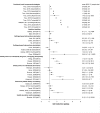Systematic review of dietary salt reduction policies: Evidence for an effectiveness hierarchy?
- PMID: 28542317
- PMCID: PMC5436672
- DOI: 10.1371/journal.pone.0177535
Systematic review of dietary salt reduction policies: Evidence for an effectiveness hierarchy?
Abstract
Background: Non-communicable disease (NCD) prevention strategies now prioritise four major risk factors: food, tobacco, alcohol and physical activity. Dietary salt intake remains much higher than recommended, increasing blood pressure, cardiovascular disease and stomach cancer. Substantial reductions in salt intake are therefore urgently needed. However, the debate continues about the most effective approaches. To inform future prevention programmes, we systematically reviewed the evidence on the effectiveness of possible salt reduction interventions. We further compared "downstream, agentic" approaches targeting individuals with "upstream, structural" policy-based population strategies.
Methods: We searched six electronic databases (CDSR, CRD, MEDLINE, SCI, SCOPUS and the Campbell Library) using a pre-piloted search strategy focussing on the effectiveness of population interventions to reduce salt intake. Retrieved papers were independently screened, appraised and graded for quality by two researchers. To facilitate comparisons between the interventions, the extracted data were categorised using nine stages along the agentic/structural continuum, from "downstream": dietary counselling (for individuals, worksites or communities), through media campaigns, nutrition labelling, voluntary and mandatory reformulation, to the most "upstream" regulatory and fiscal interventions, and comprehensive strategies involving multiple components.
Results: After screening 2,526 candidate papers, 70 were included in this systematic review (49 empirical studies and 21 modelling studies). Some papers described several interventions. Quality was variable. Multi-component strategies involving both upstream and downstream interventions, generally achieved the biggest reductions in salt consumption across an entire population, most notably 4g/day in Finland and Japan, 3g/day in Turkey and 1.3g/day recently in the UK. Mandatory reformulation alone could achieve a reduction of approximately 1.45g/day (three separate studies), followed by voluntary reformulation (-0.8g/day), school interventions (-0.7g/day), short term dietary advice (-0.6g/day) and nutrition labelling (-0.4g/day), but each with a wide range. Tax and community based counselling could, each typically reduce salt intake by 0.3g/day, whilst even smaller population benefits were derived from health education media campaigns (-0.1g/day). Worksite interventions achieved an increase in intake (+0.5g/day), however, with a very wide range. Long term dietary advice could achieve a -2g/day reduction under optimal research trial conditions; however, smaller reductions might be anticipated in unselected individuals.
Conclusions: Comprehensive strategies involving multiple components (reformulation, food labelling and media campaigns) and "upstream" population-wide policies such as mandatory reformulation generally appear to achieve larger reductions in population-wide salt consumption than "downstream", individually focussed interventions. This 'effectiveness hierarchy' might deserve greater emphasis in future NCD prevention strategies.
Conflict of interest statement
Figures




References
-
- Lozano R, Naghavi M, Foreman K, Lim S, Shibuya K, Aboyans V, et al. Global and regional moratlity from 235 causes of death for 20 age groups in 1990 and 2010: a systematic analysis for the Global Burden of Disease Study 2010. Lancet. 2012;380(9859): 2095–128. doi: 10.1016/S0140-6736(12)61728-0 - DOI - PMC - PubMed
-
- Vos T, Barber RM, Bell B, Bertozzi-Villa A, Biryukov S, Bolligeret I, et al. Global, regional, and national incidence, prevalence, and years lived with disability for 301 acute and chronic diseases and injuries in 188 countries, 1990–2013: a systematic analysis for the Global Burden of Disease Study 2013. In press, corrected proof. - PMC - PubMed
-
- Lim SS, Vos T, Flaxman AD, Danaei G, Shibuya K, Adair-Rohani H, et al. A comparative risk assessment of burden of disease and injury attributable to 67 risk factors and risk factor clusters in 21 regions, 1990–2010: a systematic analysis for the Global Burden of Disease Study 2010. The Lancet. 2012;380: 2224–2260. - PMC - PubMed
-
- Anderson CA, Appel LJ, Okuda N, Brown IJ, Chan Q, Zhao L, et al. Dietary Sources of Sodium in China, Japan, the United Kingdom, and the United States, Women and Men Aged 40 to 59 Years: The INTERMAP Study. J Am Diet Assoc. 2010;110(5): 736–45. doi: 10.1016/j.jada.2010.02.007 - DOI - PMC - PubMed
-
- Webster JL, Dunford EK, Neal BC. A systematic survey of the sodium contents of processed foods. Am J Clin Nutr. 2010;91(2): 413–420. doi: 10.3945/ajcn.2009.28688 - DOI - PubMed
Publication types
MeSH terms
Substances
Grants and funding
LinkOut - more resources
Full Text Sources
Other Literature Sources
Medical

